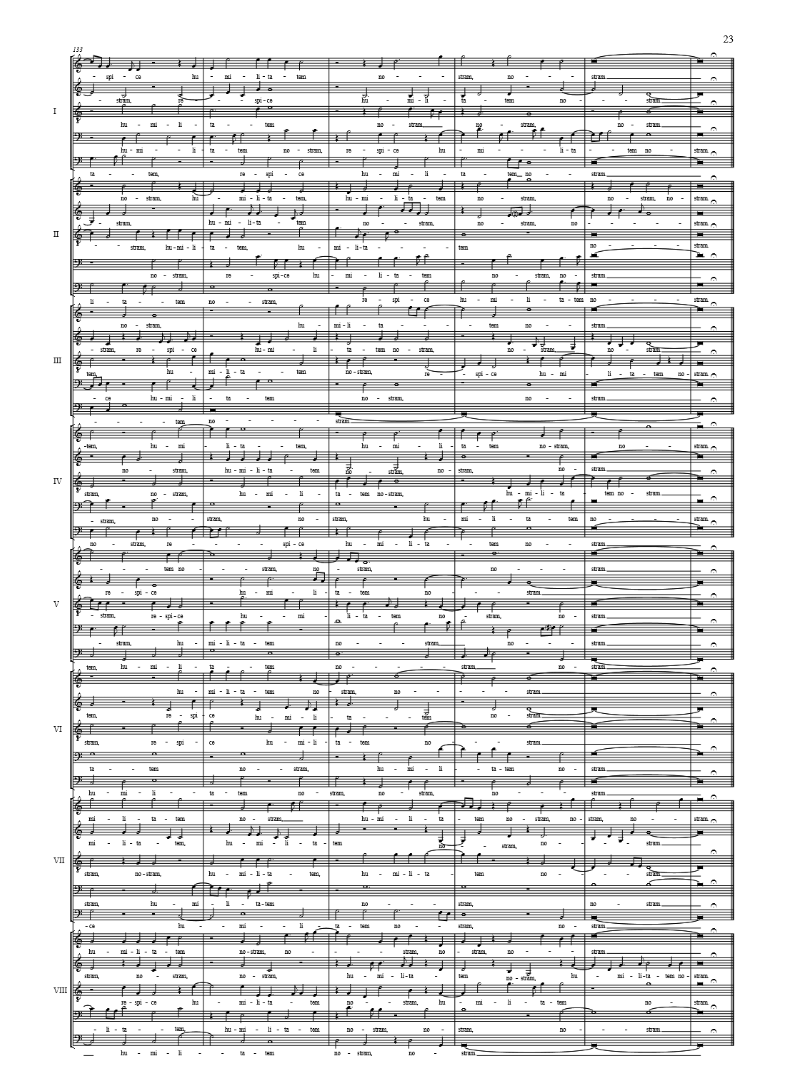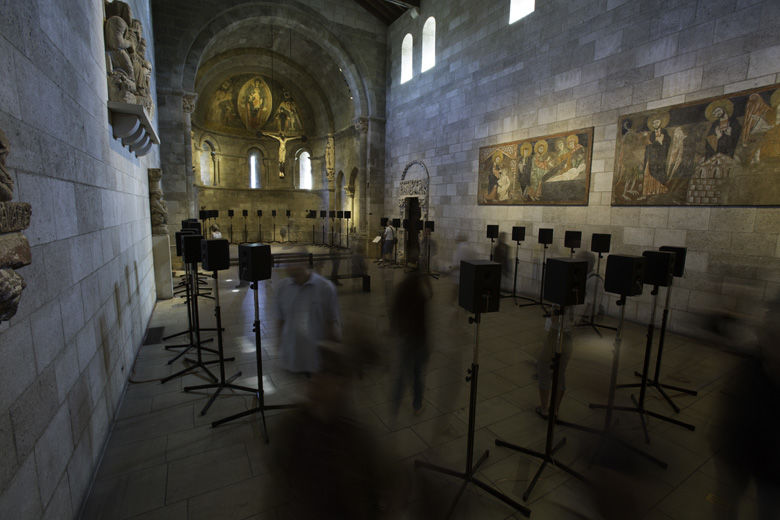The (Immersive and Transcendent) Forty Part Motet
September 23, 2013
New York, N.Y.
It's the ultimate surround sound experience: 40 loudspeakers in an oval playing the 40 individual parts of one of the most ambitious vocal compositions of all time, even if it was written over 400 years ago.
Forty vocal parts is 10 times the norm: Traditional choral music is often written in four parts called SATB — Soprano and Alto (the high and low women’s vocal ranges) and Tenor and Bass (the high and low men’s ranges). SATB choirs were the rule even in centuries gone by when women weren’t allowed to sing in the church and the high ranges were handled by boys, countertenors (men who can sing in the alto range), and sometimes castrati.
The Bach cantatas and larger works such as the St. Matthew Passion use SATB choral writing throughout. Some scholars even believe that Bach intended for his choirs to consist of only four singers, while other scholars think that Bach preferred the more common practice of having multiple singers for each part.
Six-part and eight-part choral writing is less common. The chorus in the finale of Beethoven’s Symphony No. 9 is SATB except for a section where the tenors split into two parts. Mahler’s Symphony No. 8 — the so-called Symphony of a Thousand because of the orchestral and vocal forces it demands — requires two SATB choirs and a children’s choir.
But daring composers can go higher. One of the most famous extreme cases — as well as one of the oldest — is Spem in alium (literally, “Hope in any other”), a 40-part motet by Renaissance English composer Thomas Tallis. That's 40 individual vocal lines. Here’s the last page of the score in a modern on-line edition created by Philip Legge showing all 40 simultaneous vocal parts going down the full height of the page.

Thomas Tallis was born in England around 1505 and composed music mostly for the church under three sovereigns: King Henry VIII, Queen Mary, and Queen Elizabeth. This is usually known as the Renaissance era in music, and this music is not often performed in modern concert halls. Tallis died in 1585, a hundred years before the 1685 births of archetypal Baroque composers Bach, Handel, and Domenico Scarlatti.
There is some evidence that Tallis enjoyed some number-play in his compositions, so he may have composed the 40-part Spem in alium for Queen Mary’s 40th birthday in 1556, or Queen Elizabeth’s 40th birthday in 1573, or perhaps he was inspired to the challenge after hearing another 40-part motet by Alessandro Striggio in 1567, which is to say that the oirigins of Spem in alium are obscure. The Latin text translates as:
-
I have never put my hope in any other but in you, God of Israel, who will be angry and yet become again gracious, and who forgives all the sins of suffering man.
-
Lord God, Creator of Heaven and Earth, look upon our lowliness.
The 40 vocal parts in Spem in alium are divided into eight five-voice choirs. Depending on how the score is transposed and how the available vocal forces are distributed, each choir could consist of a bass, tenor, alto, soprano, and high (i.e., child) soprano; or a bass, baritone, tenor, alto, and soprano.
There are plenty of recordings of Spem in alium; arkivmusic.com lists 67 of them. And certainly the recordings give a sense of the sonic power of 40 vocal lines. But the sheer density of sound often makes it difficult to pick out the individual parts spread across the stereo arc. A live performance is better for hearing this music, but still not quite adequate, because audiences are usually separated from the choir by the fourth wall of the concert stage or the choir loft.
What you really want with Spem in alium is to wander among the singers to get a real sense of the relationship between the individuals and the whole.
Enter audio installation artist Janet Cardiff (b. 1957) who in the year 2000 recorded the Salisbury Cathedral Choir performing Spem in alium. Each of the 40 singers was equipped with an individual microphone, resulting in a 40-channel recording that is played back in an installation work entitled The Forty Part Motet.
The Forty Part Motet has been installed in several venues since 2001, including the Museum of Modern Art in New York City in 2006. But now The Forty Part Motet is at the Cloisters, the branch of the Metropolitan Museum built to resemble a medieval monastery for the presentation of medieval (mostly ecclesiastical) art. Located in a remote area of Manhattan (take the A train to 190th Street) the Cloisters is peacefully secluded and scenically breathtaking. Most tourists seem to avoid the area or don't know about it, but New Yorkers treasure it in a very special way.
The installation is in the Fuentidueña Chapel, containing Spanish and Italian art from the 12th century:

Forty head-high Bowers & Wilkins DM-303 loudspeakers.are arranged roughly in an oval, and Spem in alium plays in a continuous loop. The composition itself is just 11 minutes long, but it is preceded by about three minutes during which the singers are chatting among themselves and getting ready for the performance.
If you look at a score (several are available on the Choral Wiki site), you'll see that the music is arranged in eight choirs of five singers each, and so are the loudspeakers. Each choir of five loudspeakers is (from left to right) bass, baritone, tenor, alto, and boy soprano. (I may be mistaken, but I believe the alto parts are all sung by countertenors, which means there are no women singing, which lends some historical accuracy to the performance.)
Spem in alium begins with the first choir only, and then the second enters, followed by the third. The loudspeakers are arranged so that the first choir is near the entrance to the Chapel (the foreground in the photograph) and the other choirs are positioned progressively clockwise around the room, so it seems as if the music is leaping through space. As the 6th choir enters, the first three drop out, and the 4th drops out as the 7th enters, but soon the earlier choirs enter again and all are at full force, which happens several times during the composition.
The hard walls of the Fuentidueña Chapel provide great resonance for music of this sort. I heard three full performances today, and the crowd varied betwen 20 and 50 people, using a variety of different strategies for experiencing the music. Some people stand in a fairly central location, or sit on one the two benches, and hear the music coming from all directions, Others wander around visiting the various choirs.
As you move around, you begin to understand more deeply that each of these loudspeakers is an individual singer, and I found myself often standing near a single singer or couple singers chosen almost at random, trying to focus on their parts in the context of the whole. Often what an individual is doing in Spem in alium makes little musical sense in isolation, but synergistically meshes with everyone else's parts in contributing to the glorious entirety of the music.
The Forty Part Motet is a unique and thrilling musical and sonic experience, and the installation at the Cloisters has instantly become one of the magical spaces of New York City. The installation will be at the Cloisters (open seven days a week) through December 8.